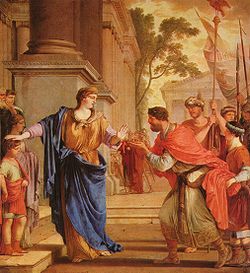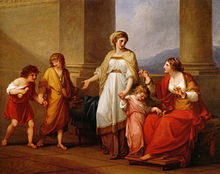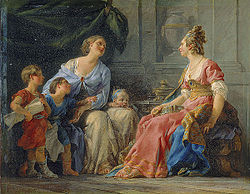- Cornelia Africana
-
 Cornelia pushes away Ptolemy's crown, by Laurent de La Hyre
Cornelia pushes away Ptolemy's crown, by Laurent de La Hyre
Cornelia Scipionis Africana (born 191 or 190 BC - died 100 BC) was the second daughter of Publius Cornelius Scipio Africanus, the hero of the Second Punic War, and Aemilia Paulla. She is remembered as the perfect example of a virtuous Roman woman.
Contents
Biography
Cornelia married Tiberius Gracchus Major, the father of Tiberius Sempronius Gracchus, when he was already in an advanced age. The union proved to be a happy one and together they had 12 children,[1] very unusual for Roman standards. Unfortunately, only three survived childhood:[2] Sempronia, married to her cousin Publius Cornelius Scipio Aemilianus; and the brothers Tiberius and Gaius Gracchus, who would defy the political institutions of Rome, with their attempts at popular reforms. After her husband's death, she chose to remain a widow, while still enjoying a princess-like status, and set herself to educate her children. She even refused the marriage proposal of King Ptolemy VIII Physcon. Later in her life, Cornelia studied Latin and Greek language and literature. Cornelia took advantage of the Greek scholars she brought to Rome, notably the philosophers Blossius from Cumae and Diophanes from Mytilene, who were to educate young men. Cornelia always supported Tiberius and Gaius, even when their actions outraged the conservative patrician families in which she was born. After their violent deaths she retired from Rome to a villa in Misenum, but continued to receive guests.
Rome worshipped her virtues and, when she died at an advanced age, the city voted for a statue in her honour.
Role in Sons' Political Careers
One of the most important aspects of the life of Cornelia is her relationship with her adult sons. Most of the information that we have on her role during this time is what Plutarch wrote in both the “Life of Tiberius Gracchus” and the “Life of Gaius Gracchus”. She is portrayed as active during their political careers, especially during Gaius’.
Plutarch writes of how Gaius removed a law that disgraced Marcus Octavius, the tribune whom Tiberius had deposed, because Cornelia asked him to remove it.[3] Plutarch states that all the people approved of this because of respect for her due to her sons and her father. Plutarch also writes that Cornelia may have helped Gaius undermine the power of the consul Opimius by hiring foreign harvesters to help provide resistance.[4] David Stockton believed that regardless of whether it is true, this story tells us that farmers and harvesters were the usual supporters of the Gracchi.[5]
A quip that Plutarch gives us is when Gaius gave a clever retort to a political opponent who had attacked Cornelia. Plutarch writes that Gaius stated:
“What,” said he, “dost thou abuse Cornelia, who gave birth to Tiberius?”[6] And since the one who had uttered the abuse was charged with effeminate practices, “With what effrontery,” said Gaius, “canst thou compare thyself with Cornelia? Hast thou borne such children as she did? And verily all Rome knows that she refrained from commerce with men longer than thou hast, though thou art a man.”[7]
If this is a true quote, we can not only assume that Cornelia's reputation as a chaste, noble woman existed during her lifetime, but that the Gracchi used this to their advantage in their political rhetoric.
Cornelia's Letter Excerpts
Cornelia is one of only four Roman women whose writings survive to present day. There are two excerpts from a letter said to have been composed in the late 2nd century BCE to Gaius Gracchus, Cornelia's younger son. But not all scholars accept these excerpts as authentic.[8] In Cornelia's letter, it documents how Roman women wielded considerable influence in a political family. The letter is possibly dated to Gaius just before his tribunate in 122 BCE. Gaius would be killed in 121 BCE while his brother Tiberius was killed a decade prior in 133 BCE. The excerpts were preserved in the manuscripts of Cornelius Nepos, the earliest Latin biographer. (ca. 110-24 BCE)2[8]
The Text:
“You will say that it is a beautiful thing to take on vengeance on enemies. To no one does this seem either greater or more beautiful than it does to me, but only if it is possible to pursue these aims without harming our country. But seeing as that cannot be done, our enemies will not perish for a long time and for many reasons, and they will be as they are now rather than have our country be destroyed and perish. . . . I would dare to take an oath solemnly, swearing that, except for those who have murdered Tiberius Gracchus, no enemy has foisted so much difficulty and so much distress upon me as you have because of the matters: you should have shouldered the responsibilities of all of those children whom I had in the past, and to make sure that I might have the least anxiety possible in my old age; and that, whatever you did, you would wish to please me most greatly; and that you would consider it sacrilegious to do anything of great significance contrary to my feelings, especially as I am someone with only a short portion of my life left. Cannot even that time span, as brief as it is, be of help in keeping you from opposing me and destroying our country? In the final analysis, what end will there be? When will our family stop behaving insanely? When will we cease insisting on troubles, both suffering and causing them? When will we begin to feel shame about disrupting and disturbing our country? But if this is altogether unable to take place, seek the office of tribune when I will be dead; as far as I am concerned, do what will please you, when I shall not perceive what you are doing. When I have died, you will sacrifice to me as a parent and call upon the god of your parent. At that time does it not shame you to seek prayers of those gods, whom you considered abandoned and deserted when they were alive and on hand? May Jupiter not for a single instant allow you to continue in these actions nor permit such madness to come into your mind. And if you persist, I fear that, by your own fault, you may incur such trouble for your entire life that at no time would you be able to make yourself happy.”[8]
In the early 40s BCE, Cicero, Nepos's contemporary, portrayed his friend Atticus as arguing for the influence of mothers on children's speech in which Atticus said he read the letters of Cornelia, mother of the Gracchi. The letters style appeared to Atticus to show that the Gracchi were heavily influenced by Cornelia's speech more than her rearing. Later in history, Marcus Fabius Quintilian (ca. 35- ca. 100) would reassert Atticus's view of Cornelia's letters when he said “we have heard that their mother Cornelia had contributed greatly to the eloquence of the Gracchi, a woman whose extremely learned speech also has been handed down to future generations in her letters” (Inst. Orat. 1.1.6).4[8] In another excerpt recounted from Cornelius Nepos “On the Latin Historians” is a letter from Cornelia to Gaius which had been verbally recited until printed by Nepos: “I would venture to take a solemn oath that except for the men who killed Tiberius Gracchus no enemy has given me so much trouble and toil as you have done because of these matters. You should rather have borne the care that I should have the least possible anxiety in old age, that whatever you did you thought it sinful to do anything of major importance against my views, especially since so little of my life remains. . . . Will our family ever desist from madness? . . . Will we ever feel shame at throwing the state into turmoil and confusion? But if that really cannot be, seek the tribunate after I am dead.”5[9]
The Cornelia Statue
After her death, a marble statue of Cornelia was erected in which only the base has survived. But her statue endured during the revolutionary reign of Sulla and became a model for future Roman women culminating with the portrait said to be of Helena, Emperor Constantine's mother four hundred years later; however, the base of Cornelia's statue was altered during the conservative attempts of later Roman reformers in which the base of her statue that gave reference to her famous sons was filed away and replaced with the inscription as “daughter of Africanus” rather than “mother of the Grachii.”6[9]
Problems in Reconstructing the Historical Cornelia
The historical Cornelia remains somewhat elusive. Reconstructing the historical Cornelia proves problematic in that the figure portrayed in Roman literature likely represents more what she signified to Roman writers than an objective account. Complicating matters, this significance changed over time as Roman society evolved, in particular the role of women. The problems in interpreting the literature are compounded by the fact only one work allegedly attributed to Cornelia herself survives, and classicists have questioned its authenticity since the nineteenth century. The Cornelia Fragments, detailed above, purport to constitute what remains of a letter written in 124 BCE to her son, Gaius, and were preserved later in the manuscripts of Cornelius Nepos, who wrote on the Gracchi.[10] In the letter, Cornelia expresses strong opposition to Gaius’ intentions to stand or the tribunate. She also urges him not to continue the revolutionary policies of his older brother Tiberius Gracchus, which led ultimately to his death. The fragments were likely included in Nepos’ Life of Gaius Gracchus, now lost.[11]
Controversy over the Fragments’ authenticity has focused on the letter’s style and content.[12] While a consensus seems to agree that the fragments do resemble the writing style and language of an educated Roman aristocrat of the late second century BCE, several observe Cornelia’s rebuking of Gaius’ policies in the letter seems to conflict what is understood about her positions preserved in other sources.[13] The vehemence with which she addresses Gaius seems to conflict, to some scholars, with what is believed regarding her maternal devotion. Because of these doubts, some scholars hypothesize the Fragments constitute either a later forgery created by someone wishing to separate Cornelia’s political ideologies from those of her sons, while others suggest they are a much later fabrication, representing a “rhetorical exercise” wherein the writer attempted to recreate what Cornelia might have said, and the letter was inadvertently included as legitimate source material in Aemilius Probus’ edition of Nepos’ works in the 5th century CE.[14] These theories themselves prove problematic, as the letter constitutes only one data point, and are therefore insufficient in reconstructing broad conclusions about Cornelia’s political ideals or making inferences about nebulous ideas of “maternal devotion.” As has also been pointed out, if they do in fact represent the work of a forger, he was an expert in the grammar, language, and writing style of the late 2nd century Roman elite.[15] A majority seems to believe that the Fragments are authentic and represent a private letter written by a highly educated woman, who never intended her stern rebuke to read by anyone but her son.
With the Fragments being the only primary source material produced by Cornelia that survive, the reconstruction of the historical Cornelia relies mainly on how later Roman writers saw her. This is problematic because Roman depictions of Cornelia clearly change over time. The earliest image of Cornelia, painted largely by Plutarch’s views, is of an aristocratic woman, spending much of her time living extravagantly in her family’s villa, who because of her family’s wealth, opportunities, and interest in education (particularly Greek), receives the best-possible education in Latin and Greek rhetoric.[16] She is somewhat controversial, both for her sons’ political policies and for having developed (and frequently making use of) such strong rhetorical abilities, despite being a woman. These early accounts emphasize her education and abilities but place comparatively much less emphasis on her maternal role.
Over subsequent centuries Cornelia evolves in the eyes of Roman writers. Her educational achievement and abilities become de-emphasized and subordinated to her place as an example of “idealized maternity.” Her education becomes incorporated into her role as the ideal mother: she achieved her education not for its own sake but in order to pass it on to her sons. She becomes excised from the political controversy that surrounded her family and is transformed into an idealized, one-dimensional figure. The Cornelia of history ultimately became adapted to fit into the moralistic agendas of later Roman writers, who used her as a vehicle to present their ideals on motherhood.[17] As the historian Emily Hemelrijk concludes, “the Cornelia we know is to a high degree a creation of later times.”[18] The historical Cornelia has largely been lost in this process of her transformation into a heroine, an idealized example for aristocratic women of later periods to pattern themselves after.
Modern Representations
 Cornelia, Mother of the Gracchi (1785) by Angelica Kauffmann.
Cornelia, Mother of the Gracchi (1785) by Angelica Kauffmann.
An anecdote, likely invented, demonstrates Cornelia's devotion to and admiration for her sons. When women friends questioned Cornelia about her mode of dress and personal adornment, which was far more simple and understated than was usual for a wealthy Roman woman of her rank and station, Cornelia indicated her two sons and said, "These are my jewels."[19]
A large statue on the grounds of the Ohio Statehouse in Columbus, entitled "These Are My Jewels," makes allusion to this story. It is surmounted by a figure of Cornelia, personifying the state of Ohio, with arms wide spread, and arrayed before her are the state's "jewels" - military and political leaders who contributed to the Union Cause during the American Civil War.
"Cornelia", a poem by Susanna Roxman, is included in her poetry collection Imagining Seals (Dionysia Press, Edinburgh 2006-7). This poem contains the lines "But I never asked for heroes./Some jewels would have been enough."
Notes
- ^ Plutarch, Life of Tiberius and Gaius Gracchus 1.5
- ^ Plutarch, Life of Tiberius and Gaius Gracchus 1.6
- ^ Plutarch, Gaius Gracchus, trans. Bernadotte Perrin (Cambridge, MA: Harvard University Press, 1921), iv.2, Perseus Digital Library, http://www.perseus.tufts.edu/hopper/text?doc=Perseus%3Atext%3A2008.01.0015%3Achapter%3D4%3Asection%3D2
- ^ Plutarch, Gaius Gracchus, trans. Bernadotte Perrin (Cambridge, MA: Harvard University Press, 1921), xiii.1, Perseus Digital Library, http://www.perseus.tufts.edu/hopper/text?doc=Perseus%3Atext%3A2008.01.0015%3Achapter%3D13%3Asection%3D1
- ^ David Stockton, The Gracchi (Oxford: Clarendon Press, 1979), 20.
- ^ Plutarch, Gaius Gracchus, trans. Bernadotte Perrin (Cambridge, MA: Harvard University Press, 1921), iv.3, Perseus Digital Library, http://www.perseus.tufts.edu/hopper/text?doc=Perseus%3Atext%3A2008.01.0015%3Achapter%3D4%3Asection%3D3
- ^ Plutarch, Gaius Gracchus, trans. Bernadotte Perrin (Cambridge, MA: Harvard University Press, 1921), iv.4, Perseus Digital Library, http://www.perseus.tufts.edu/hopper/text?doc=Perseus%3Atext%3A2008.01.0015%3Achapter%3D4%3Asection%3D4
- ^ a b c d Vivante, Bella ed. Women's Roles in Ancient Civilizations. Westport: Greenwood Press, 1999
- ^ a b Fantham, Elaine, Helene Peet Foley, Natalie Boymel Kampen and other. Women in the Classical World, Image and Text. New York: Oxford University Press,
- ^ Hemelrijk, Emily. Matrona Docta: Educated Women in the Roman Elite from Cornelia to Julia Domna. (London: Routledge, 1999), 194-6.
- ^ Hemelrijk, Emily. Matrona Docta: Educated Women in the Roman Elite from Cornelia to Julia Domna. (London: Routledge, 1999), 193-4.
- ^ Hemelrijk, Emily. Matrona Docta: Educated Women in the Roman Elite from Cornelia to Julia Domna. (London: Routledge, 1999), 194.
- ^ Hemelrijk, Emily. Matrona Docta: Educated Women in the Roman Elite from Cornelia to Julia Domna. (London: Routledge, 1999), 194-5.
- ^ Hemelrijk, Emily. Matrona Docta: Educated Women in the Roman Elite from Cornelia to Julia Domna. (London: Routledge, 1999), 194-6.
- ^ Hemelrijk, Emily. Matrona Docta: Educated Women in the Roman Elite from Cornelia to Julia Domna. (London: Routledge, 1999), 196.
- ^ Hemelrijk, Emily. Matrona Docta: Educated Women in the Roman Elite from Cornelia to Julia Domna. (London: Routledge, 1999), 28, 62-3.
- ^ Hemelrijk, Emily. Matrona Docta: Educated Women in the Roman Elite from Cornelia to Julia Domna. (London: Routledge, 1999), 67-71.
- ^ Hemelrijk, Emily. Matrona Docta: Educated Women in the Roman Elite from Cornelia to Julia Domna. (London: Routledge, 1999), 67.
- ^ Valerius Maximus, Memorable Deeds and Sayings 4.4 praefatio
References
•Plutarch. Gaius Gracchus. Translated by Bernadotte Perrin. Cambridge, MA: Harvard University Press, 1921. Perseus Digital Library, http://www.perseus.tufts.edu/hopper/text?doc=Perseus:text:2008.01.0015.
•Stockton, David. The Gracchi. Oxford: Clarendon Press, 1979.
•Fantham, Elaine, Helene Peet Foley, Natalie Boymel Kampen and other. Women in the Classical World, Image and Text. New York: Oxford University Press, 1994.
•Vivante, Bella ed. Women's Roles in Ancient Civilizations. Westport: Greenwood Press, 1999.
See also
- Women in Rome
- Cornelia — other Cornelias
- Scipio-Paullus-Gracchus family tree
External links
Categories:- Cornelii
- Cornelii Scipiones
- 2nd-century BC Romans
- 2nd-century BC women writers
- 190 BC births
- 100 BC deaths
- Ancient Roman women
Wikimedia Foundation. 2010.

